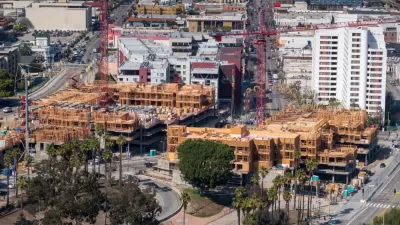Anti-housing development planning now has consequences in California.

Garth Meyer reports for Easy Reader on a notable departure from an anti-development tradition in the Southern California beach town of Redondo Beach, where a developer has proposed the development of 2,300 residential units, hotels, and offices on a 50-acre site that formerly housed an AES power plant.
The development proposal is made possible by state laws requiring local governments to make accommodations for allotted housing construction in the local housing element of the general plan through the every-eight-years process called the Regional Housing Needs Assessment (RHNA). As documented by Diana Ionescu for Planetizen in April 2022, the state's Department of Housing and Community Development (HCD) has a new mandate to enforce the requirements for local governments to complete a new housing element every eight years, enacted by a state law approved in 1969.
Redondo Beach was one of a handful of cities to run afoul of HCD regulators by under-planning for new housing—a club that includes nearby Los Angeles and Santa Monica (although Los Angeles has since rectified its position with state regulators). Nowadays, failing the RHNA test comes with the consequence of losing local control over some land use approvals. Redondo Beach is currently discovering the consequences of their inaction.
More details on the proposed development and the state laws that precipitated this historic moment in Redondo Beach and California development history can be found in an article by Steven Sharp for Urbanize LA. “Pustilnikov is also pursuing vesting rights under SB 330, which would preserve his ability to develop the property in the event that the City of Redondo Beach is able to obtain state certification of its housing element,” adds Sharp.
More on California's crackdown on housing scofflaws can be found in this August editorial published by the Los Angeles Times.
FULL STORY: Pustilnikov files for 2,320 housing units, hotel, office complex, park at AES

Study: Maui’s Plan to Convert Vacation Rentals to Long-Term Housing Could Cause Nearly $1 Billion Economic Loss
The plan would reduce visitor accommodation by 25% resulting in 1,900 jobs lost.

Alabama: Trump Terminates Settlements for Black Communities Harmed By Raw Sewage
Trump deemed the landmark civil rights agreement “illegal DEI and environmental justice policy.”

Why Should We Subsidize Public Transportation?
Many public transit agencies face financial stress due to rising costs, declining fare revenue, and declining subsidies. Transit advocates must provide a strong business case for increasing public transit funding.

Paris Bike Boom Leads to Steep Drop in Air Pollution
The French city’s air quality has improved dramatically in the past 20 years, coinciding with a growth in cycling.

Why Housing Costs More to Build in California Than in Texas
Hard costs like labor and materials combined with ‘soft’ costs such as permitting make building in the San Francisco Bay Area almost three times as costly as in Texas cities.

San Diego County Sees a Rise in Urban Coyotes
San Diego County experiences a rise in urban coyotes, as sightings become prevalent throughout its urban neighbourhoods and surrounding areas.
Urban Design for Planners 1: Software Tools
This six-course series explores essential urban design concepts using open source software and equips planners with the tools they need to participate fully in the urban design process.
Planning for Universal Design
Learn the tools for implementing Universal Design in planning regulations.
Smith Gee Studio
Alamo Area Metropolitan Planning Organization
City of Santa Clarita
Institute for Housing and Urban Development Studies (IHS)
City of Grandview
Harvard GSD Executive Education
Toledo-Lucas County Plan Commissions
Salt Lake City
NYU Wagner Graduate School of Public Service





























